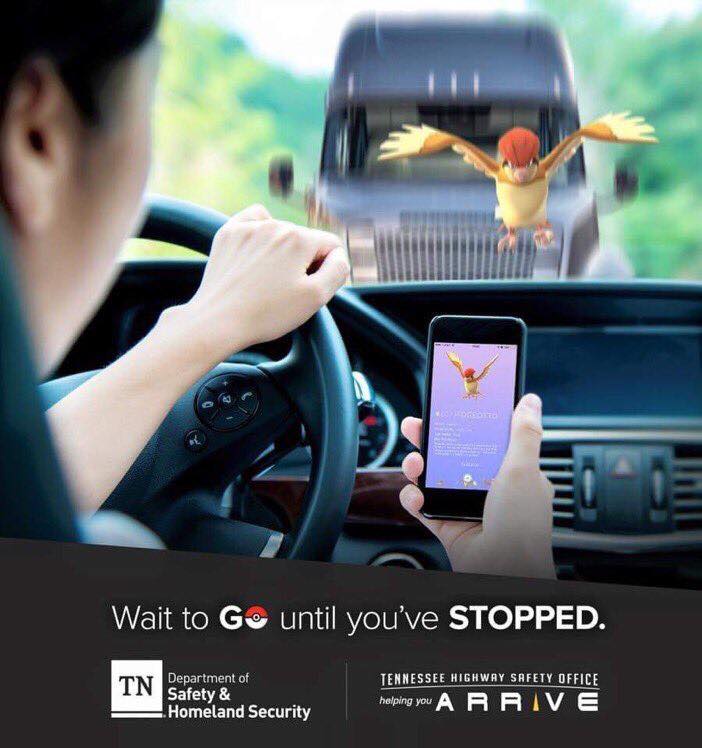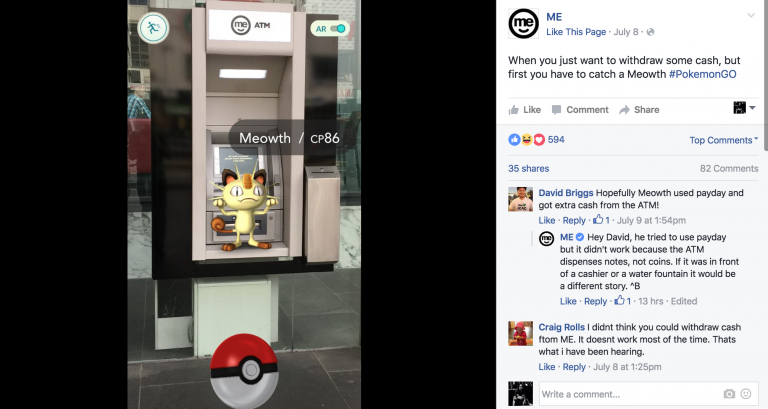
Image source: Pokémon
Pokémon GO became an overnight craze. Media outlets filled their pages with stories of people using their cell phones to search for Pokémon in stores, offices, parks – almost everywhere, sometimes gathering in large groups. The new game offers the possibility of a bonanza for marketers.
The Rise of Augmented Reality
The game uses your phone’s GPS to report where and when Pokémon creatures “appear” around you on your phone screen. The object of the game is to catch Pokémon on your phone screen by flinging Pokéballs as you travel about the (real) world. Different types of Pokémon appear based on the time and your location. Players can find a wide range of virtual creatures almost anywhere including parks, offices, grocery stores, bathrooms and even strip clubs.
Because the game combines the virtual and physical worlds, it’s called augmented reality – as opposed to the entirely digital realm of virtual reality. Despite recent hype over virtual reality, augmented reality may be the wave of the future.
The game became so popular it almost surpassed Twitter in numbers of daily active users on Android just days after its release. It may be the first truly successful version of augmented reality. It’s easy to download and play – and it’s fun.
How Businesses Can Respond
Forbes contributor Jason Evangelho recommends businesses download the app. They may learn that the game features their locale As a Pokémon hunting ground or other use. Rather than trying to limit visitors to paying customers, welcome the gamers in an effort to entice them to become customers.
One independent clothing store posted a sign that reads: “come get your PokéBalls and previously rocked threads. Gotta catch ‘em all in style!”
The Crystal Bridges Museum of American Art in Bentonville, AK, photographed the game’s creatures next to their various displays and artwork, and blogged about it on their site.
A restaurant or coffee shop could create a Pokémon-inspired drink or dish and offer players a discount, he suggests. Promotional ideas are limited only by creativity.
“Trust me when I say this game is exploding, and it stands to have a daily impact on your business,” Evangelho asserts.
Quick-acting Australian brands are also taking advantage of the game and interacting with gamers, according to AdNews. Woolworths posted on its Facebook page the hot tips to catch Pokémon in response to people finding the animated creatures in Woolworths’ stores.
Here are superb examples of references to the game found by ClickZ on Twitter. The Tennessee Highway Safety Office raised awareness of the increased dangers of playing while driving.
Whataburger in Texas and the Australian ME Bank showed humor and were some of the most relevant brand mentions.
Awaken to the Opportunity
“If you’ve not yet been convinced over the potential of AR or VR technology in capturing the imagination of a mass and diverse audience, Pokémon GO will change your mind,” writes Rachael Lonergan, head of strategy at boutique media agency Foundation, for Business Insider. “The opportunity for brands to interact within these parallel worlds is immense and largely untapped, and Pokémon GO, and games like it, are helping to normalize this type of engagement.”
Not every brand should jump into Pokémon or other augmented reality games. Marketers should study the new technologies, ponder why the game exploded into popularity and seek insights into how they can adapt to generate positive brand engagement.
“Don’t wait for your six-year-old to explain it to you. Get involved and see it for yourself,” Lonergan urges.
And, by the way, it’s not just six year olds who are playing the game. Teenagers and young adults are actively engaged for hours per day. We have four teenaged grandchildren in our house for the summer. They are all having a marvelous time playing Pokémon GO. They even get in their cars to go outside the neighborhood to find and capture more game creatures. They have visited shopping areas and local attractions in search of new Pokémon. It’s become the top summer activity of 2016 – at least in the week since the game’s introduction. Based on the enthusiasm of participants, Pokémon GO is a craze that’s likely to endure – and wise marketers will search for creative ways to capitalize.
Bottom Line: The sudden popularity of Pokémon GO highlights the potential power of augmented reality. Perceptive organizations quickly recognized the marketing opportunities of the tremendously popular game. Whether or not your brand immediately embraces the game, keeping abreast of the emerging augmented-reality technology will help brands prepare for new marketing strategies.
William J. Comcowich founded and served as CEO of CyberAlert LLC, the predecessor of Glean.info. He is currently serving as Interim CEO and member of the Board of Directors. Glean.info provides customized media monitoring, media measurement and analytics solutions across all types of traditional and social media.








Trackbacks/Pingbacks